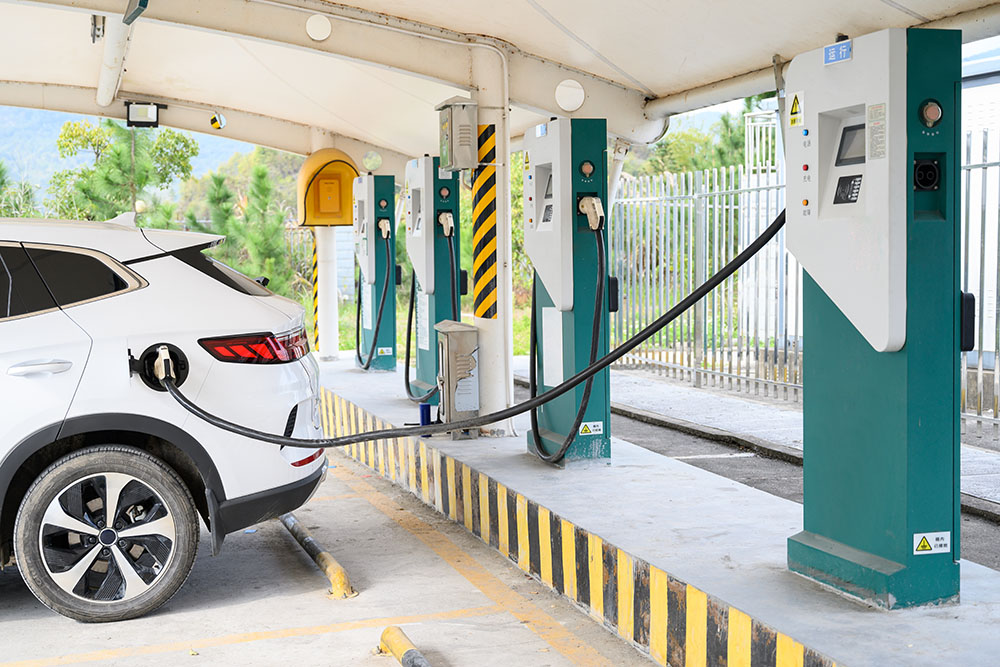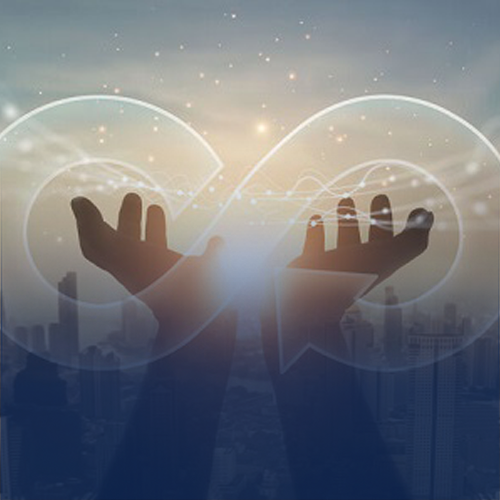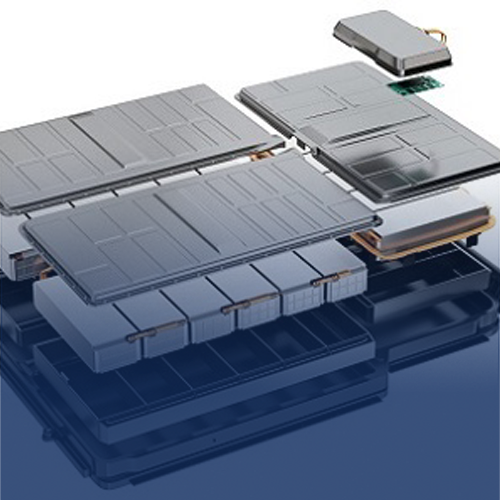
A Future Scenario for a Flourishing Circular Society
In a linear economy, massive quantities of goods are made, consumed, and then simply discarded. In a circular economy, however, very little is thrown away because most of the waste is recycled. Today, a worldwide shift to a circular economy-based society (hereinafter, “circular society”) is underway. A growing awareness of the need to protect the planet is driving more consumers to select and purchase environmentally friendly products and services. Nevertheless, the Circularity Gap Report 2022 indicates that only 8.6 percent of all minerals, fossil fuels, metals, and biomass marketed in the world go back into the economy after use1. Clearly, we need to redouble our efforts to realize a flourishing society in which people can make full use of limited resources.
Expanding Reuse and Recycling
― Toward a fully circular society
In a circular society, natural resources are used sparingly and effectively, thereby minimizing waste and reducing the environmental burden. It is true that mass production and mass consumption have greatly enriched our lives—but that comes at a price. Throughout the world, resources are being depleted, waste materials are polluting the environment, and global warming is having a devastating impact—all of which is driving the shift to a circular society.
At the United Nations Environment Assembly (UNEA) held in Nairobi, Kenya, in March 2022, 175 countries resolved to draft a legally binding international agreement to end plastic pollution. Emphasizing the importance of this initiative, a UN press release states, “A shift to a circular economy can reduce the volume of plastics entering oceans by over 80 per cent by 2040.”
Many things need to be considered in order to realize a circular society. For one thing, reuse and recycling must not be limited to plastics. For depletable resources such as oil and metals, it is also important to look beyond reuse and recycling and find ways to circulate resources at a biological level, for instance, through microbial biodegradation. We also need to expand reuse and recycling while minimizing waste by ensuring the participation of industries, people, and goods not yet involved in this endeavor.

"Our planet and our economy cannot survive if we continue with the 'take, make, use and throw away' approach. We need to retain precious resources and fully exploit all the economic value within them,”
Frans Timmermans, First Vice-President of the European Commission. “Closing the Loop: Commission Adopts Ambitious New Circular Economy Package to Boost Competitiveness, Create Jobs and Generate Sustainable Growth.” Press release by the European Union, December 15, 2015.
Multifaceted Pursuit of Resource Circulation and Efficiency
― Our scenario for the future
At Yokogawa, the transition to a circular economy through the circulation and efficient use of resources is one of the “Three goals” for sustainability that represent our vision for society in 2050. We aim to realize a society in which resources of all types are circulated without generating waste and assets are used effectively. To promote co-innovation, we will share with customers and business partners our vision for a circular society that is beneficial to all. To attain our sustainability goals, we have taken a fresh look at previous and potential future initiatives and drawn up a scenario for what we want to achieve based on our blueprint for the future.
With the aim of achieving a circular society, we have already made contributions that are helping to ensure the effective use of reclaimed water, renewable fuels, and carbon dioxide (CO2). In the US, we have recently completed a proof of concept test for optimizing operations at a wastewater reclamation facility to efficiently provide safe and secure drinking water. We are also supplying automation technology, equipment, and services to renewable fuel production facilities. In Japan, we have been undertaking a study project that examines the feasibility for collaboration between companies in different industries in a carbon recycling business at an industrial complex. This project has involved surveys on the energy balances of the companies' industrial plants as well as their capture and reuse of emitted CO2. With this inter-industry collaborative study project, we aim to promote the effective use of CO2 emissions.

Our scenario for the future creates a path by which ever more goods and materials can be reused and recycled. Visualization is key to this approach. Leveraging our core competence in measurement, we aim to visualize processes that have previously been hard to quantify and evaluate. Specifically, we are aiming at three targets.
The first target is to visualize the degree of degradation in materials. This allows goods and resources to be used for longer periods of time and enhances the performance of reused items.
Batteries are one example. Electric vehicle batteries have numerous cells that degrade at varying rates. Because of stringent safety requirements, EV batteries must be replaced at the end of their service life, even when many individual cells are still viable. Such batteries may be repurposed for stationary use. To increase the capacity of such rebuilt batteries, achieving an even balance in the degree of cell degradation is key.
With conventional technology, the remaining battery charge is shown only in relative terms, e.g., “xx percent of full capacity.” In contrast, our battery degradation diagnosis technology quantifies the remaining battery charge in watt-hours. Leveraging the expertise Yokogawa has cultivated by providing measurement and control solutions to battery developers and manufacturers, we are not only able to ensure an even balance in the capacity of the cells in reconstituted batteries but also can perform regular diagnostic checks to ensure operational safety.
The second target is to visualize recycling processes. One such process is chemical recycling, which involves breaking down chemicals to raw materials and the combination of these materials to form new substances. By visualizing this process, enhancements can be made to plant control that improve the recycling rate of used materials like plastic waste.
Chemical recycling has lately gained considerable attention because the process of breaking down materials to the molecular level to recover raw materials is not affected by the presence of foreign substances or contaminants. Yokogawa focuses on improving the chemical recycling process by visualizing the depolymerization mechanism. We are pursuing development of a process model that accurately predicts the progress of depolymerization. Applying this process model to the control of plant operations will save energy in the chemical recycling process, improve yields, and enhance the recycling rate.
The third target is to visualize the origin of regenerated goods. We focus on materials that come from resource recycling, and wish to visualize the methanation process using microbial catalysts and the associated cell culture environment. This offers a means for the reuse of CO2 emissions.
Progress is being made in the development of methanation technology that chemically converts hydrogen and CO2 to methane that can be used as fuel. When methane burns, it gives off CO2 that can be captured and reused in the methanation process. As such, this technology is a promising means for the reuse of CO2.
The conventional methanation process typically uses chemical catalysts in a high-temperature environment, which consumes a certain quantity of energy. As an alternative, we are focusing on the use of methanogenic bacteria and working with universities to research the microbial methanation process. We use our laser analyzers to monitor changes in the methanation process, and our pH sensors to monitor methanogenic bacteria cultures. By realizing a methanation process that consumes less energy, we contribute to the effective use of CO2 emissions.
As described above, Yokogawa is pursuing a variety of initiatives to achieve a fully circular society. However, promoting and widening the practice of reuse and recycling is hardly something that can be achieved by any one company acting on its own. Over the years, we have created value by utilizing our ability to make connections through the integration of useful information found at customers' production sites. Utilizing our ability to measure, we will achieve our visualization targets and bring about the use of socially accepted criteria for evaluation that will serve as a catalyst to connect organizations, businesses, and industries. On the strength of these two core competences, we will bring people, organizations, and businesses together in a value chain, and make progress toward the realization of a flourishing circular society.
References
1. Circle Economy. The Circularity Gap Report 2022. https://www.circularity-gap.world/2022.



